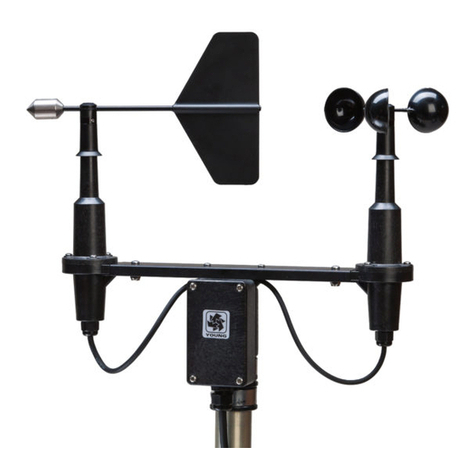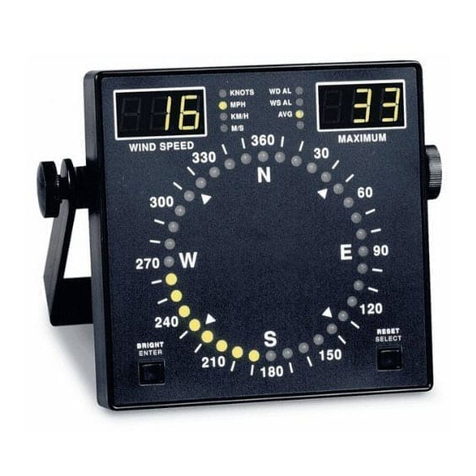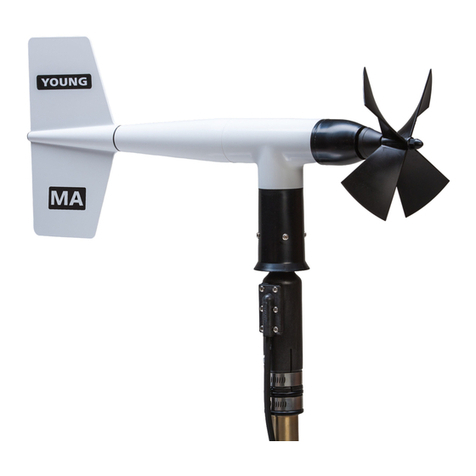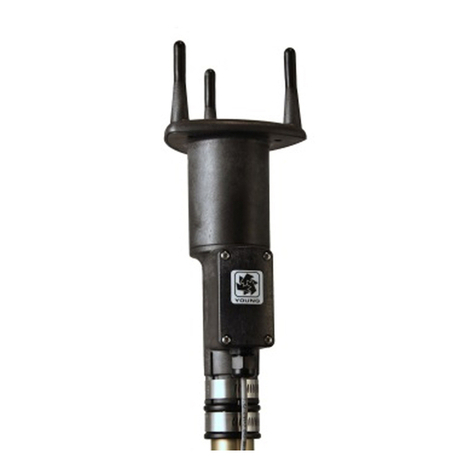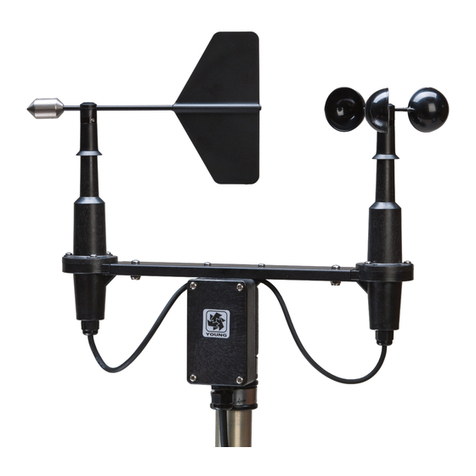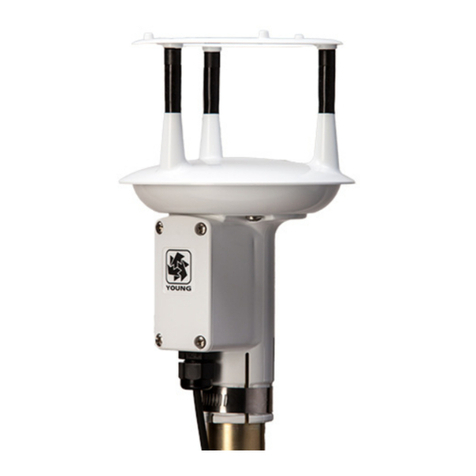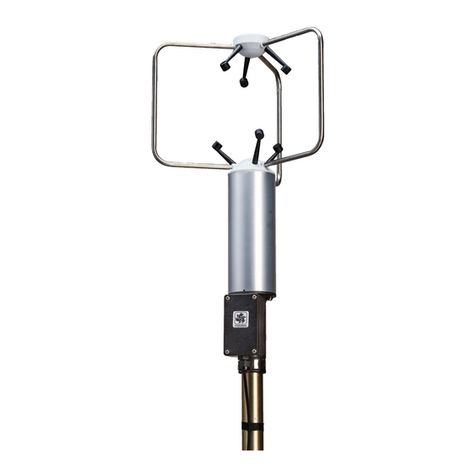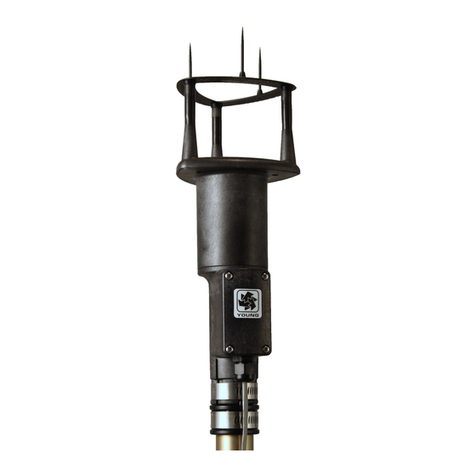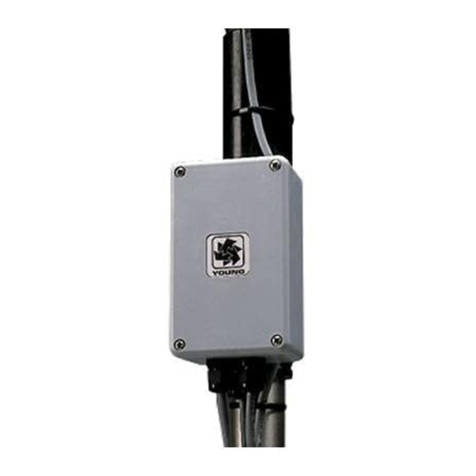
Page 2
85000-90
IMPORTANT: The Wind Tracker input option must be
set to "INP 09". See the Wind Tracker manual for set-
ting this option.
3.2 Apply power to the Wind Tracker and sensor. There will
be a 5 second delay for initialization after which the unit
will begin to send data. Wind speed and wind direction
values will appear on the Wind Tracker.
The sensor wind speed threshold is preset to 0.25 m/s
(0.6 mph). Wind below this level is displayed as zero.
The wind direction display will show the last value that
appeared when wind speed was above threshold.
3.3 Verify sensor response by using a small fan or gently
blowing through the measuring section. Move the fan to
create wind from several different directions and conrm
changes on the Wind Tracker display. Small fans and
gentle blowing create irregular ow patterns. This test is
for general checkout only.
If the Wind Tracker display continuously shows "Ser Err" then it is
not receiving data from the sensor. Remove power and check all
wiring connections. If the problem cannot be corrected, contact your
YOUNG representative.
If the 85000 is NOT USED with a YOUNG Wind Tracker, an alterna-
tive output must be used to check operation. For voltage output, a
voltmeter may be used as an indicator. For other serial formats, use
the wiring diagrams and appropriate parameter settings as a guide.
See sections 5.0 and 6.0 of this manual.
IMPORTANT: RMYT, the default serial output format, transmits
binary data. Most serial communications programs can only display
ASCII text, not binary data. Therefore, using such a program to moni-
tor RMYT output will show meaningless characters on the computer
display. To see readable data with a program like HyperTerminal,
a suitable serial output format like ASCII or NMEA must be used.
4.0 INSTALLATION
4.1 PLACEMENT
Proper instrument placement is important. Eddies from buildings,
trees, or other structures can inuence measurements. For most
applications, locate the sensor well above or upwind of obstructions.
As a general rule, air ow around a structure is disturbed to 2 times
the height of the structure upwind, 6 times the structure downwind,
and up to 2 times the height of the structure above ground.
4.2 MOUNTING AND ALIGNMENT
The sensor mounts to standard 1-inch (IPS) pipe with an outside
diameter of 1.34 inches (34 mm).
Generally, the sensor is aligned to north. In this orientation, the
sensor junction box faces south (180 degrees). The transducer may
be used as sighting aids. See diagram APPENDIX B.
4.2.1 Place orientation ring over pipe with guide pin up.
4.2.2 Place sensor mounting post over pipe.
4.2.3 Using the transducers as a sighting aid, align the sensor
with a feature on the horizon that represents the proper ori-
entation. After alignment, tighten the mounting post band
clamp to secure the position. DO NOT OVER-TIGHTEN.
4.2.4 Slide the orientation ring up so its guide pin is fully engaged
in the sensor mounting post notch. Tighten the orientation
ring band clamp to secure its position. DO NOT OVER-
TIGHTEN.
If the sensor needs to be removed later, leave the orientation ring on
the pipe to preserve sensor alignment.
4.4 CONNECTIONS
With long cable lengths, resistance in the power supply wires reduces
the available voltage at the sensor. Power at the sensor must be in
the range of 9 to 16 VDC when the sensor is operating. See WIRING
DIAGRAMS in APPENDIX A.
5.0 OPERATION
5.1 WITH YOUNG WIND TRACKER DISPLAY
The default serial output format is RMYT which is compatible with
the Young Model 06201 Wind Tracker display. The Wind Tracker
receives measurements in the form of binary data via an RS-485
serial connection. The Wind Tracker automatically converts the data
to wind values which appear on the display. Set the Wind Tracker
input to 'INP 09'. See the Wind Tracker manual for display options.
5.2 VOLTAGE OUTPUTS
When the default RMYT format is used, analog voltage outputs are
active. These may be connected to a data logger or other device
such as the YOUNG Model 26700 Programmable Translator. See
VOLTAGE OUTPUTS in APPENDIX A for connection details and
calibration values.
Voltage outputs may be enabled with any serial output format except
SDI-12 even if the serial output connection itself is disabled. Polar
speed and direction, which is the default, or Cartesian (UV) voltage
output format may be selected. See section 6.4.13 and APPENDIX
B for additional details. The voltage output may also be set to signal
the STATUS CODE. The default setting causes VOUT to ignore the
STATUS CODE. See sections 5.3.2 and 6.4.14 for additional details.
When cable length between voltage output terminals and data ac-
quisition system exceeds 3m (10 ft.), the voltage outputs should be
measured differentially.
5.3 SERIAL OUTPUT FORMATS
A variety of serial output formats are available in the 85000. From the
factory, it is programmed for operation with the Young Wind Tracker
display (RMYT format). Other serial formats are selected using a PC
and the Windows 2DSETUP program (2Dsetup.exe) provided. The
following sections discuss format options available. Each command
is discussed in detail in section 6.0.
5.3.1 RMYT
RMYT is a 6-byte binary data format sent at 9600 baud using the
RS-485 OUTPUT ONLY connections. This format is used with the
YOUNG Model 06201 Wind Tracker. RMYT is the default setting so
the sensor may be connected to a Wind Tracker without altering any
other sensor parameters.
If RMYT default parameters are used (no other parameters altered),
the maximum number of internal samples are always used, measure-
ments and outputs run continuously, voltage outputs are enabled,
and both RS-232 and RS-485 connections are enabled. The average
current consumption is about 150 mA, not including heater power.
